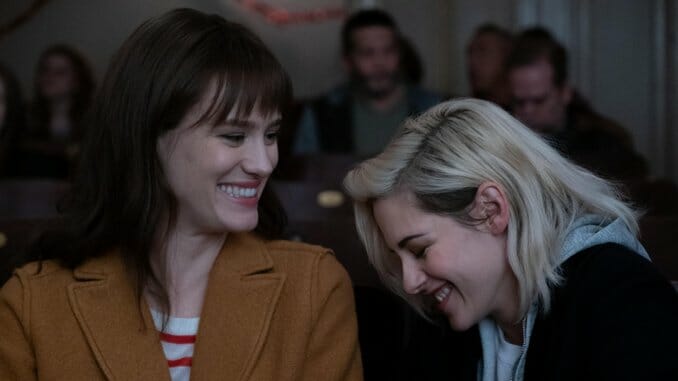Happiest Season‘s Kristen Stewart and Mackenzie Davis Bolster Christmas Pap with Queer Identity
Photos Courtesy of Hulu
“Will you shut up and follow me please?” If Mackenzie Davis put this question to you, you’d say “yes” and shuffle up the scaffolding on a stranger’s home just to sit with her and enjoy a breathtaking view of a town aglow with holiday lights. Then you would tumble off the stranger’s roof like sloughing snow and interrupt said strangers’ Christmas-themed BDSM. You would also be Kristen Stewart and you would be co-starring in Happiest Season, director/co-writer Clea Duvall’s sophomore follow-up to her 2016 debut The Intervention, which reclaims the holiday movie for LGBTQ cinema.
Stewart’s casting alone signals an intention to melt the cheese that’s characteristic of the seasonal niche. Happiest Season does so over well-considered and multifaceted thoughts on queer identity, like what the subtle violence of being trapped in the closet can do to a person’s spirit. Pittsburgh political reporter Harper Caldwell (Davis) has plans to head home for Christmas to spend it with her family. Unlike the year prior, she’s decided to invite her girlfriend Abby (Stewart) along for the trip. The Caldwells’ annual Christmas bash is the stuff of legends and, more importantly, Harper wants to introduce her partner to her parents, city councilman/mayor aspirant Ted (Victor Garber) and Tipper (Mary Steenburgen).
Of course, there’s the catch: Harper hasn’t told mom and dad about Abby, or that she’s gay. Meanwhile she has told Abby the exact opposite, and drops this grenade in Abby’s lap when they’re a blink away from meeting the folks. Coltish lesbian hijinks ensue. Abby poses as Harper’s roommate, lies about dating scads of dudes (including her most recent ex, a milkman), and altogether tries gamely to pass herself off as straight. It works. Duvall doesn’t have a ton of faith in fundamentally hetero people possessing a functional gaydar, and besides that, she isn’t making The Wedding Banquet. Ignorance is a condition she must actively maintain. But Harper’s inevitable revelation of her sexual orientation is besides the point. Happiest Season functions primarily as insight into queer experience over hetero perspective.
What to do when you’re out and proud until you’re at home with your parents? Abby is at first supportive of Harper’s plan: Keep the relationship mum until after New Year’s. But Happiest Season lets her contentment decay over passing days as family interactions teeter more and more on the brink of disaster. Harper, for instance, has an outwardly hostile dynamic with her younger sister Sloane (Alison Brie) and a dynamic with their youngest sister Jane (Mary Holland, also the film’s co-writer) best described as “benignly neglectful.” To her parents, specifically Ted, she’s a trophy, a secret weapon to trot out in social situations where her refinement and professional success ingratiate him with potential donors and allies. She doesn’t get to have a personality. She’s only given enough room to be a punching bag or a step ladder. Duvall dramatizes that tension through Harper’s actions but lets the audience see it through Abby’s eyes, which stay bewildered and glassy as soon as they arrive at Ted and Tipper’s place. What Harper has with them is antithetical to what Abby had with her own late parents. (Her status as an orphan is a running gag throughout. She’s Margot Tenenbaum and everyone else is Royal.)